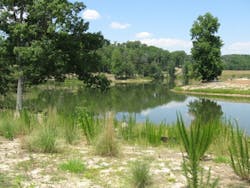Best Management Practices (BMPs): The Installation Element
Part 2 of a three-part series on stormwater Best Management Practices
Read part 1 > Best Management Practices (BMPs): The Design Element
Read part 3 > Best Management Practices (BMPs): The Maintenance Element
When something fails, we often hear, "It sure looked good on paper!" All too often, this is the case with water quality projects. A massive effort has been made to develop standard practices and proprietary products that can be used in the development of a water quality plan. Those efforts continue today and improvements are being made to many BMPs as results in the field have shown us what works well and what does not. We have learned that climate, soils and on-site conditions vary greatly, and a "one size fits all" approach does not work very well. New initiatives have emerged that require new elements in a water quality plan, such as retention of water on site. While BMP design is far from perfect, the truth is that we have made significant improvements over the past 20 years, and those improvements continue as we learn more from research and field data. If we call design "Step One" in the process, "Step Two" is the construction and installation of the BMPs called for in the design.
Almost every BMP is manufactured. Some are products produced by a proprietary manufacturer, but public domain BMPs are also manufactured from soil, aggregate, concrete, vegetation and other materials. Almost no BMPs are natural features that already exist, although natural wetlands and other bodies certainly provide additional water quality if we are able to protect them from most of the pollutants in stormwater discharge. Proprietary products are relatively easy to inspect after their manufacture, but once they are delivered to a construction site, there may be little or no supervision or inspection. During the construction process for land-based BMPs, there are also critical aspects that need to be inspected or supervised. Unfortunately, the inspection process tends to break down for many reasons, including a lack of staff and personnel at the jurisdictional level.
While this article is mainly concerned with permanent, post-construction BMPs, almost everything said here applies to construction phase BMPs as well. In fact, a properly designed "Erosion and Sedimentation" plan can be totally ineffective if the structural controls (such as silt fence, check dams, etc.) and the surface protection (mulching, hydro-seeding, erosion control mats, etc.) are not properly installed and maintained. This is critical during construction, as permanent controls often have to be installed early in a project and can be literally destroyed by poor erosion and sedimentation control.
Some BMPs rely on infiltration as a part of their effectiveness. While infiltration is not possible on every site, in some cases it provides a very effective way to retain excess volume on site. Not only does it reduce run-off volume, it also provides important support for the water table and helps maintain the base flows of streams in dry conditions. When infiltration is a part of the plans, there are special provisions that need to be made to be sure that the natural ability of the soils to infiltrate water is not compromised. Typically, the infiltration area is carefully covered with a structural material, such as graded stone, or a porous top cover to protect the soil from compaction over time and to preserve its ability to percolate water downward into the water table. All too often, a contractor will be concerned with the ability of the structural system to support the surface use, and he will compact the soil in the infiltration area, just as he would the rest of the site. The plan might have looked good on paper but it will never infiltrate water as it was intended to do. Beyond compromising the infiltration process, holding water in the porous spaces above the soil layer may actually weaken the area over time or cause surface flooding. Engineers tend to add standard details about soil protection and preparation, as well as detailed site-specific instructions for soil preparation in many cases, but often these details are completely ignored in the field. If no supervision or inspection is dictated in the plans, an effective BMP may be completely useless if the installation is faulty.
If the "pond" storage area is underground, effective erosion control during construction becomes critical. When there is underground storage, the ability to clean out sediment is severely restricted, and is often very expensive. Beyond the concerns of excess sedimentation, poor soil preparation may also affect the outlet control structures, headwalls and rip-rap that are necessary to keep the pond operational.
Due to the fact that the soils on site and the soil preparation are such critical elements, it is important to add an inspection step to the construction process once clearing and grading begin. It might be tempting to require extensive soil analysis prior to permitting, but many problems will literally be uncovered as the site is opened up, no matter how much drilling and sampling is done.
For critical infiltration sites, it certainly is a good idea to sample the soil in the infiltration area to get critical data on the percolation rate, particle size distribution, and structural characteristics. On most sites, this would not be necessary: Good grading contractors generally assess the site and formulate a good plan for utilizing (or hauling off) the poor material on a site. In the best case, any problem with the soils should be a topic of discussion with the site engineer, the contractor and the inspector. This is the time to emphasize the importance of the water quality elements on the site and how they depend on the soil in many cases. If this is ignored, and the contractor is not aware of the critical nature of some BMP requirements, the results may not be what the designer intended.
Another problem that often crops up is the improper installation of structural elements like pipes, junction boxes and other drainage features. For many years, these structures were simply used to convey water from one place to the other. Today, they may be storing water for long periods of time, under significant pressure. If a site has a detention/retention facility that is eight feet deep, and maintains a four foot permanent pool, a pipe that enters the facility at the bottom will always be full of water, and may have a "head" pressure that can cause leakage at the joints. Sometimes materials are substituted (and allowed by field inspectors) that do not meet the requirements of a more expensive product. Even when the correct product is used, every joint must be constructed with care to protect the system from leaking and undermining the pipes and structures. Proper compaction of the soil and proper bedding are necessary to make these systems work as designed.
Proprietary devices suffer from poor installation as well. Many have to be constructed in the field by contractors who have no idea how they work. Often, the devices are installed in excavations that have not had proper soil preparation at their base. We see poor pipe connections, as some of the devices cannot be entered to "mud out" the pipe, and the outside is already backfilled. Often, the devices cannot function properly because the inverts are not correctly set so that the water level in the device is per specifications.
Although the critical mistakes that can be made at installation time for a BMP are far too numerous to list here, it's clear that improper installation is a major problem in achieving good water quality. A good first step for improvement in this area is the responsibility of the design engineer. Proper installation procedures should be detailed for every BMP. For some items, this can be "boiler plate" but many require careful thought and attention to detail. The contractor must be aware of critical items in the installation and what to do if he encounters problems on the site. A second step is to identify critical inspection points and require that the inspections be done and reported back to the designer. This might be an inspection of an infiltration bed prior to covering it up, or another critical construction step. From a jurisdictional viewpoint, strict inspection of the erosion and sedimentation controls and practices on a site is the number one requirement to protect post-construction BMPs.
These steps may cost additional time and money to complete, but the amount of money spent on these activities pales when we think of all the money wasted on planning, designing, and constructing BMPs that look good on paper but will never function to improve water quality. This is a colossal waste of time and effort that can be avoided with just a bit more attention to detail.
Read part 1 > Best Management Practices (BMPs): The Design Element
Read part 3 > Best Management Practices (BMPs): The Maintenance Element


